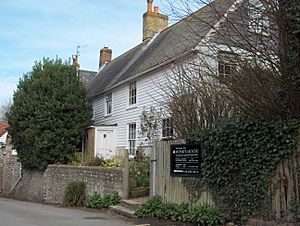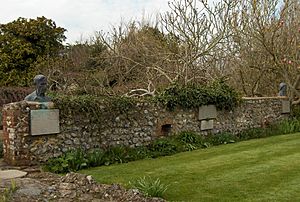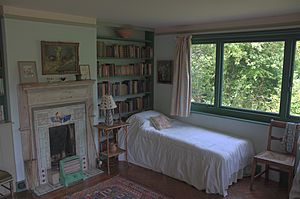Monk's House facts for kids
Quick facts for kids Monk's House |
|
|---|---|
| Monk's House | |
 |
|
| Location | The Street, Rodmell, East Sussex, England |
| Built | 18th-century |
| Owner | The National Trust |
|
Listed Building – Grade II
|
|
| Official name: Monks House | |
| Designated | 27 September 1979 |
| Reference no. | 1273935 |
| Lua error in Module:Location_map at line 420: attempt to index field 'wikibase' (a nil value). | |
Monk's House is a charming cottage from the 16th century. It is located in the village of Rodmell, about three miles (4.8 km) south of Lewes in East Sussex, England. This historic house became famous because the well-known writer Virginia Woolf and her husband, Leonard Woolf, lived there. Leonard was a journalist and editor who cared deeply about social issues.
The Woolfs bought Monk's House on July 1, 1919, for 700 pounds. They often welcomed many friends from the Bloomsbury Group to their home. This group was made up of writers, artists, and thinkers. Famous visitors included T. S. Eliot, E. M. Forster, and Roger Fry. Virginia's sister, the artist Vanessa Bell, lived nearby at Charleston Farmhouse. Both houses were important meeting places for the Bloomsbury Group. Today, the National Trust looks after Monk's House. It is open to the public as a museum dedicated to the writer.
Contents
Life at Monk's House
When the Woolfs first moved to Rodmell, Monk's House was a small home. It had a garden of about three-quarters of an acre, which included an orchard and other small buildings. The house was quite simple at first. Over the years, the Woolfs made many changes to make it more comfortable.
They improved the kitchen and added a hot water system. They also put in a bathroom with a toilet. In 1929, they added a two-story extension to the house. To keep the beautiful views from their garden, they bought the field next door in 1928. This field looked out towards Mount Caburn.
Virginia Woolf's Writing Space
The Woolfs began spending more and more time in Rodmell. From 1940, they lived there full-time. This was because their flat in London was damaged during an air raid. The quiet village life gave Virginia a break from the busy city. She found peace in a small wooden lodge at the bottom of her garden. This is where she wrote many of her famous novels.
Some of the books she wrote there include Jacob's Room (published in 1922) and Mrs Dalloway (1925). She also wrote To The Lighthouse (1927), Orlando (1928), and The Waves (1931). Other works like The Years (1937) and Between The Acts (1941) were also created in this special place. Her last novel, Between the Acts, was published after her death in July 1941. This book includes many details about Rodmell village life.
Virginia also loved to take photographs of her life at the house. These pictures are kept in the Monk's House Albums. They show portraits and group photos of the many people who visited her home.
Leonard Woolf's Life in Rodmell
Virginia Woolf sadly passed away in 1941. Leonard continued to live at Monk's House until he died in 1969. He was very involved in the village community. Both he and Virginia were members of a political party that focused on social equality. Leonard became a manager of the village school in Rodmell in the 1930s. He was also a leader in the local gardening society.
Monk's House Today
After Leonard's death, the house was given to his close friend, the artist Trekkie Parsons. She sold it to the University of Sussex in 1972. Later, in 1980, the house was given to the National Trust.
Today, Monk's House is open for visitors to explore. You can see the ground floor, which includes the sitting room, dining room, and kitchen. Virginia's bedroom is also on display. Her special writing lodge can still be found at the bottom of the garden. From there, you can enjoy beautiful views across to Mount Caburn.
See also
 In Spanish: Monk's House para niños
In Spanish: Monk's House para niños



